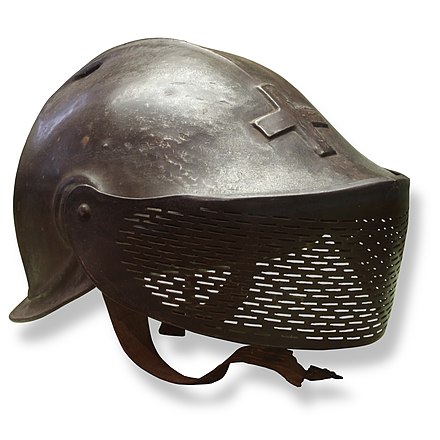
The L'Eplattenier helmet was a prototype military helmet designed for the Swiss Army by Charles L'Eplattenier in 1916. Deemed too expensive to produce en masse, it was shunned in favour of a simpler design.

The L'Eplattenier helmet was a prototype military helmet designed for the Swiss Army by Charles L'Eplattenier in 1916. Deemed too expensive to produce en masse, it was shunned in favour of a simpler design.
The outbreak of World War I was deemed important enough for Switzerland to enact a general mobilization on 3 August, 1914. Three divisions were raised, reinforcing the border defense in order to prevent a possible spillover of the fighting into Swiss territory. The introduction of the steel Stahlhelm and Adrian helmets by Germany and France respectively, prompted the Swiss Army to commission Charles L'Eplattenier, a patriotic sculptor, to develop a suitable counterpart. By 1916, Swiss entry into the war was becoming increasingly improbable, enabling L'Eplattenier to draw upon romantic paintings of Swiss battles. The Swiss War Department was concerned with obtaining a steel helmet comparable to foreign models in function, while also distinguishing it from the rest of the world by achieving aesthetic superiority. [1]
The end result resembled the 1916, Franco-American, Dunand helmet, being however deeper on the sides and longer on the brow, while also bearing the characteristic Swiss cross which is embossed on the forehead. The detachable lining, is held on a carrier made of rattan, above it, two intersecting arches house a small cushion, which supports the main weight of the helmet. The helmet was first presented to the public on 15 September 1917, when divisional commander Tretoyens de Loys posed with it, in an unauthorized photo shoot which was included in an issue of Schweizer Illustrierte. The helmet was praised for its beauty, originality and Swiss character. A second version of the helmet was produced in 1918, reducing the visor's size. It was rejected due to its difficult manufacturing process and replaced with a simpler model, designed by First Lieutenant Paul Boesch. The new helmet removed the visor (deemed redundant) and the embossed cross, making it possible to manufacture it from a single plate of nickel-steel. [2]
L'Eplattenier renounced the new model as a poor imitation of the Stahlhelm, while also filing a lawsuit against the Swiss government which brought him 30,000 swiss francs. The helmet's only deployment came on the day of the Armistice, when troops oversaw the progress of a general strike organized by revolutionary socialists. A second lawsuit was filed in 1930, by the German company Tarfwerke, which alleged that the Swiss had illegally plagiarized a patent in their possession. The lawsuit was dismissed by the Swiss Federal Court, however Tarfwerke pressed on, filing for violation of cultural properties and eventually winning 5,000 reichsmarks. [3]
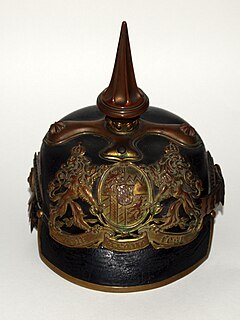
The Pickelhaube, also Pickelhelm, is a spiked helmet worn in the 19th and 20th centuries by Prussian and German military, firefighters and police. Although typically associated with the Prussian Army, which adopted it in 1842–43, the helmet was widely imitated by other armies during that period. It is still worn today as part of ceremonial wear in the militaries of certain countries, such as Sweden or Colombia.

A helmet is a form of protective gear worn to protect the head. More specifically, a helmet complements the skull in protecting the human brain. Ceremonial or symbolic helmets without protective function are sometimes worn. Soldiers wear helmets, often made from lightweight plastic materials.

Der Stahlhelm, Bund der Frontsoldaten, commonly known as Der Stahlhelm, was a German First World War ex-servicemen's organisation existing from 1918 to 1935. It was part of the "Black Reichswehr" and in the late days of the Weimar Republic operated as the paramilitary wing of the Monarchist German National People's Party (DNVP), placed at party gatherings in the position of armed security guards (Saalschutz).

A hard hat is a type of helmet predominantly used in workplace environments such as industrial or construction sites to protect the head from injury due to falling objects, impact with other objects, debris, rain, and electric shock. Suspension bands inside the helmet spread the helmet's weight and the force of any impact over the top of the head. A suspension also provides space of approximately 30 mm between the helmet's shell and the wearer's head, so that if an object strikes the shell, the impact is less likely to be transmitted directly to the skull. Some helmet shells have a mid-line reinforcement ridge to improve impact resistance. The rock climbing helmet fulfills a very similar role in a different context and has a very similar design.

The Brodie helmet is a steel combat helmet designed and patented in London in 1915 by John Leopold Brodie. A modified form of it became the Helmet, Steel, Mark I in Britain and the M1917 Helmet in the U.S. Colloquially, it was called the shrapnel helmet, battle bowler, Tommy helmet, tin hat, and in the United States the doughboy helmet. It was also known as the dishpan hat, tin pan hat, washbasin, battle bowler, and Kelly helmet. The German Army called it the Salatschüssel. The term Brodie is often misused. It is correctly applied only to the original 1915 Brodie's Steel Helmet, War Office Pattern.

The sallet was a combat helmet that replaced the bascinet in Italy, western and northern Europe and Hungary during the mid-15th century. In Italy, France and England the armet helmet was also popular, but in Germany the sallet became almost universal.

The Stahlhelm is a specific type of German military headgear made of steel, which is primarily intended to provide protection against fragments of grenades. The term Stahlhelm refers both to a generic steel helmet, and more specifically to the distinctive German military design.
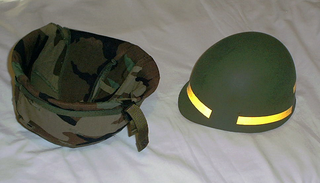
The M1 helmet is a combat helmet that was used by the United States military from World War II until 1985, when it was succeeded by the PASGT helmet. For over forty years, the M1 was standard issue for the U.S. military. The M1 helmet has become an icon of the American military, with its design inspiring other militaries around the world.

The M15 Adrian helmet was a combat helmet issued to the French Army during World War I. It was the first standard helmet of the French Army and was designed when millions of French troops were engaged in trench warfare, and head wounds from the falling shrapnel generated by indirect fire became a frequent cause of battlefield casualties. Introduced in 1915, it was the first modern steel helmet and it served as the basic helmet of many armies well into the 1930s. Initially issued to infantry soldiers, in modified form they were also issued to cavalry and tank crews. A subsequent version, the M26, was used during World War II.

The football helmet is a piece of protective equipment used mainly in gridiron football. It consists of a hard plastic shell with thick padding on the inside, a face mask made of one or more plastic-coated metal bars, and a chinstrap. Each position has a different type of face mask to balance protection and visibility, and some players add polycarbonate visors to their helmets, which are used to protect their eyes from glare and impacts. Helmets are a requirement at all levels of organized football, except for non-tackle variations such as flag football. Although they are protective, players can and do still suffer head injuries such as concussions.
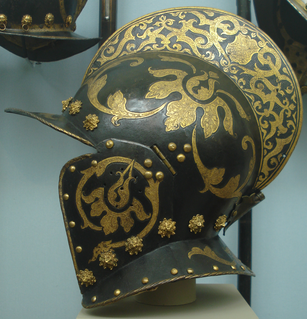
The burgonet helmet was a Renaissance-era and early modern combat helmet. It was the successor of the sallet.

The hełm wz. 31 was the basic combat helmet of the Polish Army before the outbreak of World War II and during the Invasion of Poland. The helmet became the basic type of combat headgear for Polish military formations in 1930s and during the early stages of World War II. It was also exported to Persia, Albania and Republican Spain. By September 1939 approximately 320,000 copies were delivered to the Polish Army.

For centuries, firefighters have worn helmets to protect them from heat, cinders and falling objects. Although the shape of most fire helmets has changed little over the years, their composition has evolved from traditional leather to metals, to composite helmets constructed of lightweight polymers and other plastics.

The Bulgarian M36 helmet was the basic helmet of the Bulgarian Army prior to the outbreak of World War II and during the Bulgarian participation in the war. Its latest variant is still in service along with several different modern helmets, but is being phased out in favor of more modern kevlar helmets.

Charles L'Éplattenier (1874–1946) was a Swiss painter and architect who created the Swiss version of Art Nouveau, called Style Sapin.

Greenwich armour is the plate armour in a distinctively English style produced by the Royal Almain Armoury founded by Henry VIII in 1511 in Greenwich near London, which continued until the English Civil War. The armoury was formed by imported master armourers hired by Henry VIII, initially including some from Italy and Flanders, as well as the Germans who dominated during most of the 16th century. The most notable head armourer of the Greenwich workshop was Jacob Halder, who was master workman of the armoury from 1576 to 1607. This was the peak period of the armoury's production and it coincided with the elaborately gilded and sometimes coloured decorated styles of late Tudor England.

The Luftwaffe was the air force of Nazi Germany prior to and during World War II. Luftwaffe styles of uniform and rank insignia had many unique features between 1935 and 1945. By Hitler's decision on February 26, 1935, the Luftwaffe was to be officially the third branch of the Wehrmacht as of March 1, 1935. The new Luftwaffe was faced with the problem of uniforms, as they wanted a uniform distinct from those of the other two branches of the Wehrmacht and also wanted a clear differentiation in dress of military and civilian flyers.

The M33 Helmet is a steel combat helmet designed in the 1930s in Italy, and was the standard combat helmet of the Regio Esercito up to World War II, and of the Esercito Italiano well into the Cold War.
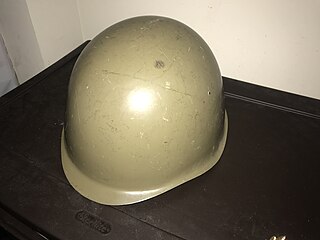
The Czechoslovakian M53 helmet was used by the Czechoslovak Army from the early 1950s onward. In western European countries and the United States, it is sometimes referred to as the Czech M53 helmet. These helmets are commonly mistaken for, and sometimes marketed as, Soviet SSh-40 helmets, and various other very similar Eastern Bloc helmets.

The M1918 helmet is a steel military combat helmet used by Switzerland from its introduction in 1918 to its replacement by the M1971. In 1943 improvements would be made to the design to which it would be called the M1918/40.